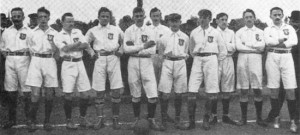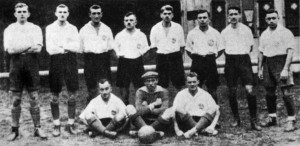WORLD CHRONICLES (1910-1930) – 5
Germany
The Berlin daily Deutsches Blatt had the brilliant idea of starting a supraregional cup competition and donated a trophy. This tournament, played in knockout format, started with the 1906/07 season and was under the auspices of the “Verband Berliner Ballspielvereine” (VBB) [Berlin Association of Clubs for Ball Games]. It met with little interest, though, and many matches were cancelled and not rescheduled. Organisation also left much to be desired, and both the public and the media soon lost interest in the tournament.
Berliner Thorball- und Fußball-Club Viktoria 1889 won the first three consecutive cup competitions, thus firmly establishing their dominance in Berlin football, because they also won the VBB championships in these three seasons. Halfway through the 1909/10 season Ballspiel-Club, Britannia 1892, Hertha 1892, Preussen 1894, Union 1892 and cup holder Viktoria 1889 withdrew from the cup competition after the various rounds were rescheduled several times. In summer 1910 all the top Berlin clubs withdrew from this cup competition for good. It would be 12 years before the VBB would attempt to revive the tournament.
Below are shown the Berliner Pokal [Berlin Cup] finals. Otto Dumke and Helmut Röpnack scored three goals each for Viktoria 1889.
| 22.06.1907 | Berliner T u. FC Viktoria 1889 | – Berliner Ballspiel-Club | 2:0 |
| 24.05.1908 | Berliner T u. FC Viktoria 1889 | – Berliner T u. FC Union 1892 | 4:0 |
| 24.10.1909 | Berliner T u. FC Viktoria 1889 | – Berliner FC Preussen | 4:1 |
| 10.07.1910 | Weißensee‘er FC 1900 | – Berliner SC Fortuna 1894 | 4:1 |
Berliner T u. FC Viktoria 1889 – Cupwinners 1907 & 1908: F. l. t. r. Paul Kralle, Adolf Deni, Otto Dumke, Willi Knesebeck, Paul Scranowitz, Willi Hahn, Helmut Röpnack, Paul Fischer, Paul Hunder, Reinhard Bock, Emil Reinke.
In the 1910’s, German football consisted of seven regional FAs. “Süddeutscher Fußball-Verband” (SFV) [South German Football Association] was the second, and only regional FA during this decade, to start up a cup competition. The first season, 1917/18, even kicked off during World War I. The clubs and the public both showed great interest. Ten years later, an undertaking which had failed in Berlin met with great success in southern Germany.
Below are given the Süddeutscher Pokal finals. Many former internationals played in this tournament, such as Alfréd Schaffer of Hungary, Gustav Bark of Switzerland (both 1. FC Nürnberg), as well as the Germans Hans Hagen, Andreas Franz, Georg Löblein (all SpVgg. Fürth), Heinrich “Heiner” Stuhlfauth, Anton Kugler, Carl Riegel, Wolfgang Strobel, Luitpold Popp, Heinrich Träg (all 1. FC Nürnberg), Josef “Sepp” Herberger (SV Waldhof Mannheim).
| 21.4.1918 | SpVgg. Fürth | – FC Stuttgarter Kickers | 2:1 |
| 14.9.1919 | 1.FC Nürnberg | – Stuttgarter SC | 5:2 |
| 17.7.1920 | Stuttgarter SC | – SV Waldhof Mannheim | 5:3 |
1.FC Nürnberg – Cupwinners 1919: Back. f. l. t. r. Alfréd Schaffer, Carl Riegel, Dr. Hans Kalb, Heinrich Träg, Luitpold Popp, Péter Szabó, Tröbs, Gustav Bark; Front, f. l. t. r. Willi Böß, Heinrich Stuhlfauth, Anton Kugler.
________________________
Iraq
The area of and around the modern Iraq, with the two rivers Euphrates and Tigris (Furat resp. Dijla in Arabic), was called Mesopotamia in Antiquity and was highly developed. This area was conquered by the Persians in 539 b.c. and by Alexander the Great in 331 a.d.. It was then ruled by the Seleucids, the Parthians and the Sassanids of Persia before the Arabs conquered it in 635-637. The region also traded much with China. As a result, tsu chu(the ancient Chinese football) was known there.
In the 12th century, then, the area of modern Iraq was conquered by the Seljuks, in 1258 by the Mongols, and in the early 15th century the area came under Turkish rule. In 1499 it was conquered by the Safawids from Persia, and was a province of the Ottoman Empire from 1534 until World War I. Games similar to football already existed there in the 19th century, as evident from paintings found in the city Nafar west of Afak in the province of al-Qadissiya (later al-Diwaniya). Modern association football, however, only was introduced by the British after World War I. For the 2,500 years before that, the main sports in the area had been various types of wrestling and boxing.
Late in the 19th and early in the 20th century, football was occasionally being played in Basra, Mosul and Baghdad; particularly in the city-port Basra, the door to Europe, teams were assembled on the spot to play against teams from foreign merchant vessels and war ships. Also, students returning to Iraq from Istanbul and other cities of the Ottoman Empire brought football back with them. The name Iraq was given to this region around 630 a.d., when the Muslim caliphs conquered it and annexed it to the Persian empire. More precisely, the name Iraq derives from the Arabic araqa. Iraq is also the Latin name for Uruk. Uruk, located in the area where southeastern Iraq is now, was a city in ancient Mesopotamia which was struggling for its freedom.
After Ottoman forces were defeated in the Mesopotamian campaign during World War I, the British occupied the areas around Mosul, Baghdad and Basra. In April 1920 Great Britain received the mandate for these regions at the San Remo conference in Italy. Even though Iraq set up a monarchy, it still became a British colony, and was maintained one by heavy deployment of British forces. The Royal Air Force (RAF) set up bases in the occupied areas – including football pitches, which were fenced like the rest of the camp. The largest and most important camp was the one in Hinaidi (south of Baghdad), which later was renamed Camp al-Rasheed. The soldiers and employees of the Royal Army played much football at this one and other camps.
After 2,500 years of foreign rule, the Iraqis naturally distrusted foreign customs. Gradually, however, they warmed to football and adopted it. Eventually, teams were spontaneously assembled to play against the British-Indian military teams (many of the British soldiers who fought in the Mesopotamian campaign were recruited from India). Major Humphrey Ernest Bowman (Director of Education) did much to promote sports at Iraqi schools. Gaining the oil fields mollified the British, and so they began teaching football to grammar school pupils and students in Baghdad at the Sheikh Omar Ground. This was also where on March 17, 1918, the first football match was played between two Iraqi school teams. In April 1921 the first football competition in Iraq was held: It was organised by the Ministry for Education and only school teams were admitted.
Following the discovery of oil at Baha Gurgur in 1927, football teams were formed in Kirkuk by the British, Armenians, Italians and Turks working there. By the early 1920’s, football had spread to the entire country through the educational system, and soon the first competitions were played, organised by the Baghdad Football Association. In 1923 the first cup competition was held, the “Batola Jamiya Korat al-Kadem”, which was open to teams from schools, universities, companies and the military. One year later, this regional association organised a championship which was contested by 16 teams and won by Thanawiya al-Merkaziya. The British seemed to be losing control of football in Iraq, and so ruled that Casual Club Baghdad (a British club) would henceforth be in charge of organising this yearly regional championship; which from 1927 to 1936 was known as Casual’s Cup.
The first and oldest Iraqi football club, al-Quwa al-Jawiya [Air Force], was founded on July 4, 1931, by a group of pilots who had recently graduated from the RAF base at Hinaidi – only 74 days after the Iraqi Air Force was founded, on April 22, 1931. The founders were five Iraqi graduates who had finished their four-year air force training at RAF Cranwell College (London) and landed at al-Washash Airport only a few weeks earlier. There were widespread celebrations when al-Jawiya beat the British team from the Habbaniva RAF base on July 5, 1931, and the club was greatly popular thereafter. The club seemed to be getting too strong for the British, who reacted by trying to get rid of the club directors. In 1933, however, king Ghazi came to power. He knew the young pilots, and thanks to his lawyers things turned out well for the club.
Only two years after its foundation, this club was a dominant force in Iraqi football and won several competitions (Army Cup, Physical Education Cup, Air Force Cup, Casual’s Cup). However, these were all regional or inofficial tournaments. There still was no Iraqi national football association, which would not be founded until October 8, 1948. During the second half of the 1930’s, talented Iraqis at the various military bases were coached by the British and so improved their game. As a result, mixed British-Iraqi teams were becoming increasingly commoner.


